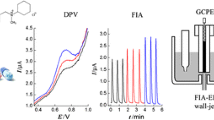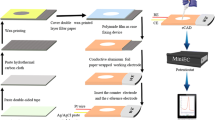Abstract
A flexible instrument was designed in order to investigate the influence of current magnitude, current duration and the frequency of the pulse generation on the error obtained in coulometric Karl Fischer titrations carried out in diaphragm-free cells. For a given current magnitude the lowest errors were obtained for current durations more than 60% of the total time for the pulse cycle. No significant influence of the pulse frequency (5–1000 Hz) was found independently of the pulse current duration for three different types of reagents intended for diaphragm-free coulometry. For all reagents, the errors obtained with the home-built instrument were significantly smaller than those obtained with an optimized commercial titrator based on pulsed current generation. Using optimum conditions for the former instrument, in combination with an imidazole-buffered reagent at pH 10 containing chloroform as modifier, the accuracy was close to 100%. Thus, it is now possible to achieve the same high accuracy with diaphragm-free coulometry as with the conventional diaphragm based technique. The precision of the water determinations was affected by the size of the background.
Similar content being viewed by others
Author information
Authors and Affiliations
Additional information
Received: 16 March 2000 / Revised: 17 May 2000 / Accepted: 22 May 2000
Rights and permissions
About this article
Cite this article
Nordmark, U., Rosvall, M. & Cedergren, A. Optimum conditions for pulse generation in diaphragm-free Karl Fischer coulometry. Fresenius J Anal Chem 368, 456–460 (2000). https://doi.org/10.1007/s002160000508
Issue Date:
DOI: https://doi.org/10.1007/s002160000508




